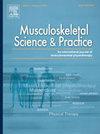Do clinical practice guidelines for low back pain include predatory journal or retracted publications? A meta-research study
IF 2.2
3区 医学
Q1 REHABILITATION
引用次数: 0
Abstract
Background
Following clinical practice guidelines is widely recommended for treating many musculoskeletal diagnoses, including low back pain, but it is unknown if clinical practice guidelines for low back pain do.
Objective
Assess whether clinical practice guidelines for low back pain reference publications from predatory journals or include retracted publications.
Design
Meta-research.
Methods
Clinical practice guidelines focusing on the management of adults with low back pain published between January 2010–June 2024 were included. All referenced publications in each guideline were evaluated for predatory categorization using a systematic process that included assessing publisher/journal websites, the Directory of Open Access Journals, Beall's List and major literature databases. The Retraction Watch Database was used to assess retraction status.
Results
Nineteen clinical practice guidelines with 1617 unique publications met inclusion criteria. The majority of publications (1598/1617; 98.8 %) were categorized as ‘non-predatory.’ Fourteen publications (0.9 %) were categorized as ‘predatory,’ two (0.1 %) ‘presumed predatory,’ and three (0.2 %) were retracted. Four guidelines cited ‘predatory’ and/or ‘presumed predatory’ publications, and four guidelines cited the retracted publications.
Conclusion
Only 1.2 % of the cited publications included in clinical practice guidelines for the management of low back pain were deemed predatory or retracted, implying that guideline recommendations are unlikely to be influenced by their inclusion. There are currently no standard criteria for how to manage the inclusion of these publications in guidelines or systematic reviews. Future research should investigate the development of a valid and reliable checklist that allows authors to assess for and manage the presence of predatory or retracted publications.
腰痛的临床实践指南是否包括掠夺性期刊或撤回的出版物?元研究
临床实践指南被广泛推荐用于治疗许多肌肉骨骼诊断,包括腰痛,但目前尚不清楚腰痛的临床实践指南是否这样做。目的评估腰痛临床实践指南是否有来自掠夺性期刊的参考出版物或包括撤回的出版物。方法纳入2010年1月至2024年6月期间发表的针对成人腰痛管理的临床实践指南。每个指南中所有引用的出版物都被评估为掠夺性分类,使用一个系统的过程,包括评估出版商/期刊网站、开放获取期刊目录、Beall's List和主要文献数据库。使用撤稿观察数据库评估撤稿状态。结果19份临床实践指南和1617份独特出版物符合纳入标准。大多数出版物(1598/1617;98.8%)为非掠食性。14篇论文(0.9%)被归类为“掠夺性”,2篇(0.1%)被归类为“推定掠夺性”,3篇(0.2%)被撤回。四份指南引用了“掠夺性”和/或“推定掠夺性”出版物,四份指南引用了撤回的出版物。结论:腰痛治疗临床实践指南中只有1.2%的引用文献被认为是掠夺性或撤回性的,这意味着指南建议不太可能受到纳入的影响。目前还没有关于如何管理将这些出版物纳入指南或系统评价的标准标准。未来的研究应该调查开发一个有效和可靠的清单,使作者能够评估和管理掠夺性或撤回出版物的存在。
本文章由计算机程序翻译,如有差异,请以英文原文为准。
求助全文
约1分钟内获得全文
求助全文
来源期刊

Musculoskeletal Science and Practice
Health Professions-Physical Therapy, Sports Therapy and Rehabilitation
CiteScore
4.10
自引率
8.70%
发文量
152
审稿时长
48 days
期刊介绍:
Musculoskeletal Science & Practice, international journal of musculoskeletal physiotherapy, is a peer-reviewed international journal (previously Manual Therapy), publishing high quality original research, review and Masterclass articles that contribute to improving the clinical understanding of appropriate care processes for musculoskeletal disorders. The journal publishes articles that influence or add to the body of evidence on diagnostic and therapeutic processes, patient centered care, guidelines for musculoskeletal therapeutics and theoretical models that support developments in assessment, diagnosis, clinical reasoning and interventions.
 求助内容:
求助内容: 应助结果提醒方式:
应助结果提醒方式:


